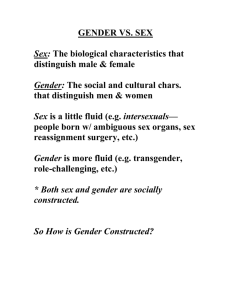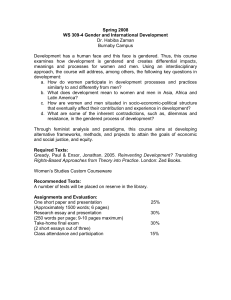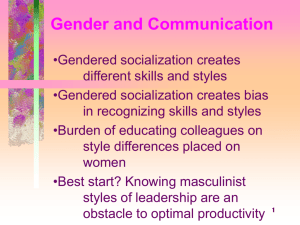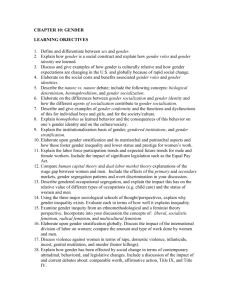gender acquisition
advertisement
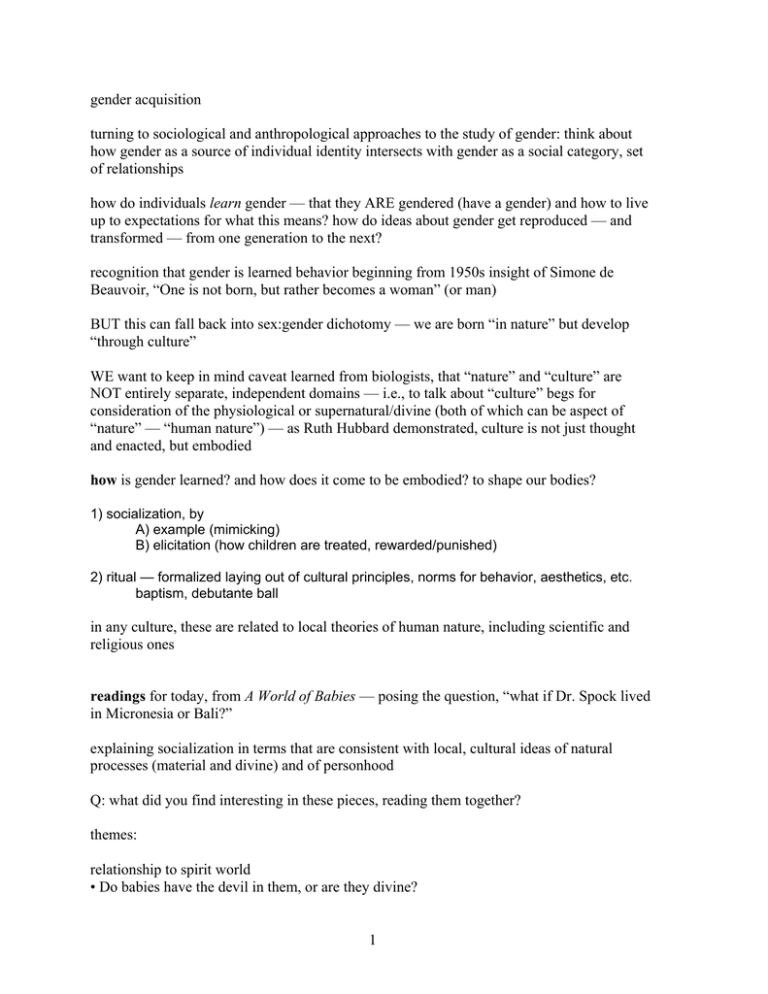
gender acquisition turning to sociological and anthropological approaches to the study of gender: think about how gender as a source of individual identity intersects with gender as a social category, set of relationships how do individuals learn gender — that they ARE gendered (have a gender) and how to live up to expectations for what this means? how do ideas about gender get reproduced — and transformed — from one generation to the next? recognition that gender is learned behavior beginning from 1950s insight of Simone de Beauvoir, “One is not born, but rather becomes a woman” (or man) BUT this can fall back into sex:gender dichotomy — we are born “in nature” but develop “through culture” WE want to keep in mind caveat learned from biologists, that “nature” and “culture” are NOT entirely separate, independent domains — i.e., to talk about “culture” begs for consideration of the physiological or supernatural/divine (both of which can be aspect of “nature” — “human nature”) — as Ruth Hubbard demonstrated, culture is not just thought and enacted, but embodied how is gender learned? and how does it come to be embodied? to shape our bodies? 1) socialization, by A) example (mimicking) B) elicitation (how children are treated, rewarded/punished) 2) ritual — formalized laying out of cultural principles, norms for behavior, aesthetics, etc. baptism, debutante ball in any culture, these are related to local theories of human nature, including scientific and religious ones readings for today, from A World of Babies — posing the question, “what if Dr. Spock lived in Micronesia or Bali?” explaining socialization in terms that are consistent with local, cultural ideas of natural processes (material and divine) and of personhood Q: what did you find interesting in these pieces, reading them together? themes: relationship to spirit world • Do babies have the devil in them, or are they divine? 1 • nature/nurture — both cultures recognize interplay; indeed, doesn’t make sense to try to separate them Bali: reincarnation of ancestor’s soul, contributing factor personality and character shaped by day of birth Ifaluk: spirit world is ever-present — in procreation, in whether infant will survive • how to teach infants, small children proper behavior? emphasize managing emotions (without apparent distinction b/w boys/girls), although for different reasons — similar practices can have different meanings Barrie Thorne’s social psychology piece on gender socialization in US Thorne takes up the questions (from Euro-American cultural perspective) • “what’s in children’s nature”? • how is gender learned, how does gender socialization happen? observations in a co-ed pre-school class found that kids internalize adult expectations and reproduce them amongst themselves BUT they internalize these only to an extent — we can see dichotomies in kids’ interactions, but we can also see them bridging the divisions — sex play, gendered play, is more fluid than is often represented by toy stores, parents, teachers parents’ insistence that they didn’t make their kid stereotypically boy/girl — if I didn’t try to ideology is never totalizing — masks fissures, tensions, contradictions, exceptions much of it has to do with adults seeing what we expect to see, not noticing — or according social significance to — behavior that challenges norms insight: we should look for gendered practices, not gender roles — see distinction? how individuals use gender creatively, strategically v. how gendered individuals act or behave (phrasing question that way inevitably leads to overgeneralization) let’s talk more about RITUAL Rites of Passage ritualized occasion of transition from one status, social position, age to another can be seen to happen at a variety of scales 2 paradigmatically in “life crises” – such as? pregnancy, childbirth, death, marriage adolescence (Mead) 3 phases of a rite of passage (from Victor Turner, elaborating Van Gennep): 1) separation physical separation of individual from rest of society symbolic separation from past 2) transition (the liminal period; margin) “betwixt & between” neither old status nor new one; statusless, identityless “no longer classified and not yet classified” – nonperson this is the stage he elaborates — gaining of secret knowledge; training often symbolic cleansing / rebirth (bloodletting) 3) (re)incorporation return to society, but in new position, with new status & new obligations & rights – new roles e.g., birth (transition for mother to certain kind of female adulthood; also for baby) DISCUSSION QUESTIONS: 1) re-narrate Ifaluk birth as a Rite of Passage — what elements fit the 3 stages? 2) what “rites of passage” are used to frame transitions related to gender/sexuality in the US? what are defining rituals in “making” a boy/girl? or graduating to adult man/woman? what do these rituals say about “what’s in children’s nature”? 3) what other rituals teach lessons about appropriately gendered behavior, values? sum up: learning gender — as an aspect of child socialization — happens not only with reference to ideas about biology (sex) — but ideas about cosmology, procreation, what it means to be human; basic moral values; notions of personhood is individualism or communalism stressed? is being nurturing seen as gendered, or not? infant care practices reflect this set of beliefs — directed at protecting the life of children, but also to guide children toward becoming accepted members of their societies eg: co-sleeping or separate beds/rooms — reflects moral values — developing 3 individualism, independence, or reflecting sense that isolation = loneliness and that can lead to illness ALSO, we can’t talk about becoming a boy/girl, man/woman without specifying becoming an Ifaluk man/woman, Balinese man/woman — a ‘high status’ Balinese man/woman. Etc. TUESDAY — start to put this in a historical frame, and link personal categories of identity — girl/boy — to political categories of social groups — women/men read first 125 pages of Middlesex, plus articles 4 MIT OpenCourseWare http://ocw.mit.edu 21A.231J / WGS.455J Identity and Difference Spring 2006 For information about citing these materials or our Terms of Use, visit: http://ocw.mit.edu/terms.
